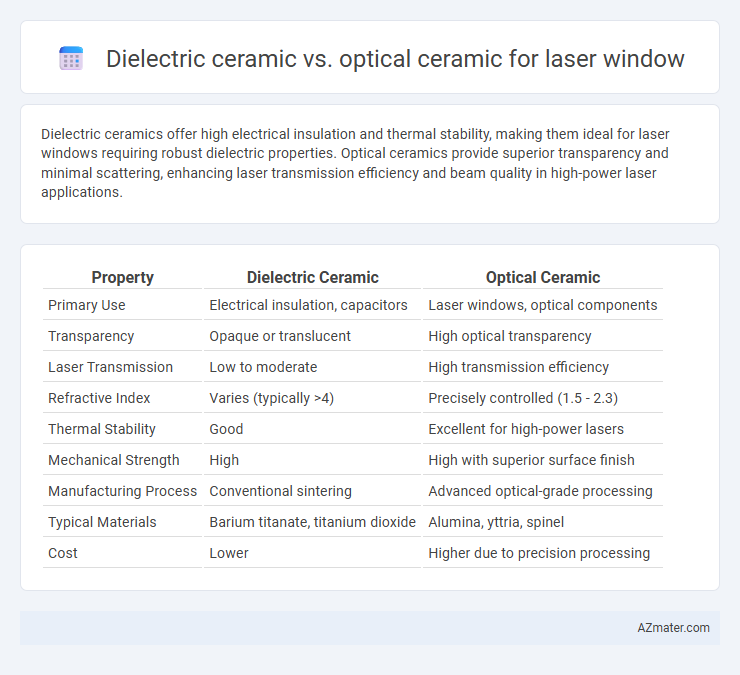Dielectric ceramics offer high electrical insulation and thermal stability, making them ideal for laser windows requiring robust dielectric properties. Optical ceramics provide superior transparency and minimal scattering, enhancing laser transmission efficiency and beam quality in high-power laser applications.
Table of Comparison
| Property | Dielectric Ceramic | Optical Ceramic |
|---|---|---|
| Primary Use | Electrical insulation, capacitors | Laser windows, optical components |
| Transparency | Opaque or translucent | High optical transparency |
| Laser Transmission | Low to moderate | High transmission efficiency |
| Refractive Index | Varies (typically >4) | Precisely controlled (1.5 - 2.3) |
| Thermal Stability | Good | Excellent for high-power lasers |
| Mechanical Strength | High | High with superior surface finish |
| Manufacturing Process | Conventional sintering | Advanced optical-grade processing |
| Typical Materials | Barium titanate, titanium dioxide | Alumina, yttria, spinel |
| Cost | Lower | Higher due to precision processing |
Introduction to Laser Window Materials
Dielectric ceramics used in laser windows offer high electrical insulation and thermal stability, making them ideal for high-power laser applications. Optical ceramics provide superior light transmission and low scattering, ensuring minimal signal loss and high laser beam quality. Choosing between dielectric and optical ceramics depends on application-specific requirements such as wavelength range, mechanical strength, and thermal conductivity.
Overview of Dielectric Ceramics
Dielectric ceramics for laser windows are engineered to exhibit high dielectric strength, thermal stability, and low optical absorption, making them ideal for insulating components in high-power laser systems. These materials typically include alumina, zirconia, and silica-based ceramics, which offer excellent resistance to thermal shock and electrical insulation while maintaining mechanical robustness. In contrast to optical ceramics, dielectric ceramics prioritize dielectric properties and mechanical durability over optical transparency, serving crucial roles in protecting laser elements and managing electromagnetic interference.
Overview of Optical Ceramics
Optical ceramics used for laser windows offer superior transparency, uniformity, and environmental resistance compared to dielectric ceramics, enabling higher laser power transmission with minimal scattering and absorption. These ceramics are engineered at the microstructural level to achieve fine grain sizes and isotropic optical properties, ensuring exceptional durability under high thermal and mechanical stress. Advanced optical ceramics such as polycrystalline alumina and yttria provide enhanced laser damage thresholds and improved performance in high-energy laser applications.
Key Material Properties: Dielectric vs Optical
Dielectric ceramics for laser windows exhibit high electrical insulation, low dielectric loss, and superior thermal stability, making them ideal for environments with strong electromagnetic interference. Optical ceramics, however, prioritize transparency, low scattering, and precise refractive index control to maintain laser beam quality and minimize signal distortion. Key distinctions include dielectric ceramics' resistance to electric breakdown versus optical ceramics' enhanced optical clarity and homogeneity critical for high-power laser applications.
Transmission Characteristics and Wavelength Compatibility
Dielectric ceramics offer excellent transmission characteristics in the ultraviolet to near-infrared wavelength range, typically from 200 nm to 2,500 nm, making them suitable for laser windows requiring broadband operation and high laser-induced damage thresholds. Optical ceramics, on the other hand, provide superior transmission in the mid-infrared range, typically from 3 um to 12 um, with low absorption and high homogeneity, crucial for applications involving CO2 and other mid-IR lasers. Selecting between dielectric and optical ceramics depends on the laser wavelength compatibility and required optical clarity, where dielectric ceramics excel in visible to near-IR lasers, and optical ceramics dominate in mid-IR laser systems.
Mechanical Strength and Thermal Stability
Dielectric ceramics used for laser windows typically exhibit superior mechanical strength due to their robust crystal structures and high fracture toughness, making them resistant to mechanical stresses and impacts. Optical ceramics, while engineered for exceptional transparency and low optical scattering, often have optimized grain structures that enhance thermal stability, allowing them to withstand rapid temperature changes without significant deformation or thermal shock. In laser window applications, combining the mechanical resilience of dielectric ceramics with the thermal durability of optical ceramics is crucial to maintaining performance under high-power laser operations.
Durability and Environmental Resistance
Dielectric ceramics for laser windows offer superior durability due to their high mechanical strength and resistance to thermal shock, making them ideal for harsh environments. Optical ceramics provide excellent environmental resistance with low absorption and high transmission rates, ensuring stable performance under varying humidity and temperature conditions. Combining mechanical robustness with optical clarity, optical ceramics often withstand prolonged exposure to UV radiation and corrosive atmospheres better than traditional dielectric options.
Application Suitability in Laser Systems
Dielectric ceramic materials for laser windows offer high resistance to thermal shock and excellent dielectric properties, making them ideal for high-power laser applications requiring electrical insulation. Optical ceramics, such as alumina or YAG, provide superior optical transparency and homogeneity, essential for minimizing scattering and maximizing beam quality in precision laser systems. Selecting between dielectric and optical ceramics depends on balancing thermal durability with optical clarity to optimize performance in specific laser applications like cutting, welding, or medical treatments.
Cost and Manufacturing Considerations
Dielectric ceramics offer lower material and processing costs compared to optical ceramics, making them more affordable for large-scale production of laser windows. Optical ceramics require precise manufacturing techniques such as hot isostatic pressing and advanced polishing, increasing their overall production expenses. The choice between dielectric and optical ceramics depends on balancing cost-efficiency with the required optical clarity and performance in laser system applications.
Future Trends in Laser Window Ceramics
Dielectric ceramics and optical ceramics both play critical roles in laser window applications, with dielectric ceramics offering superior electrical insulation and optical ceramics providing enhanced transparency and thermal stability. Future trends in laser window ceramics emphasize the development of advanced nanostructured materials combining high laser damage thresholds, improved thermal conductivity, and tailored refractive indices to optimize performance in high-power laser systems. Innovations in additive manufacturing and surface coating technologies are expected to further enhance the durability and efficiency of laser windows under extreme operating conditions.

Infographic: Dielectric ceramic vs Optical ceramic for Laser window
 azmater.com
azmater.com